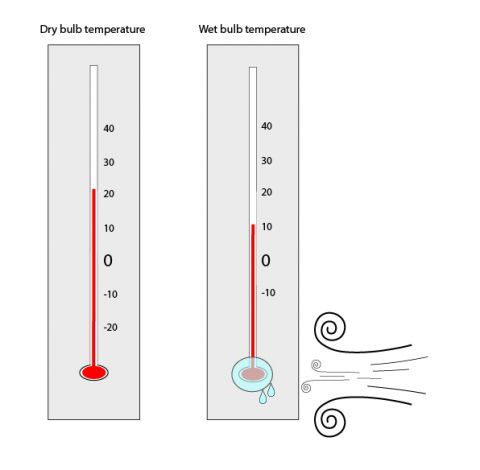What is the wet bulb temperature?
What is the wet bulb temperature?
The wet bulb temperature is crucial for the design and dimensioning of a cooling tower. A cooling tower cools water by evaporation to temperatures that are lower than the ambient temperature and that approach the wet bulb temperature. But what exactly is the wet bulb temperature and how do you calculate it?
What is the wet bulb temperature?
The wet bulb temperature is the lowest temperature achieved by adiabatic evaporation (= without adding heat or with equal enthalpy) of water in the air until the air is saturated (absolute humidity rises).
Heat is required to evaporate water. If this evaporation is adiabatic, the heat is extracted from the environment (e.g. the air), causing the air to cool down and become more humid. The same thing happens when we step out of the shower or the swimming pool. The water on our body evaporates, extracts heat from our body and we get cold.
How do you measure the wet bulb temperature?
The wet bulb temperature can be measured with a thermometer whose mercury reservoir is contained in a cotton stocking. It is kept wet by connecting it to a water tank with a cotton thread. The thermometer is placed in an air stream. Because the water evaporates, heat is extracted from the environment, including the mercury reservoir, and the measured temperature will decrease. The water continues to evaporate until the air is saturated; the relative humidity is then 100%. The temperature reaches an equilibrium and that’s the wet bulb temperature. When the air is dry, more water can evaporate and the wet bulb temperature will be lower. The greater the difference between the dry bulb temperature (or the normal temperature) and the wet bulb temperature, the drier the air is and the more water can evaporate.
Difference with dew point temperature?
The wet bulb temperature is not the same as the dew point temperature. The dew point is the temperature at which water vapor begins to condense by cooling the air (lower enthalpy) without adding or removing moisture (absolute humidity remains constant). The dew point is lower than the wet bulb temperature which in turn is lower than the dry bulb temperature (if the relative humidity is less than 100%).
How do you calculate the wet bulb temperature?
So we can conclude there is a connection between the dry bulb temperature, the wet bulb temperature, the dew point and the humidity. This relationship can be shown by means of a psychrometric diagram.
- The vertical black lines are the dry bulb temperature (°C)
- The horizontal black lines are the absolute humidity (kg/kg)
- The oblique purple lines are lines of equal enthalpy (kJ/kg)
- The curved green lines are the relative humidity (%)
To determine the wet bulb temperature, we have to determine the intersection between the vertical of the dry bulb temperature and the curved line of the relative humidity. From there you draw a parallel to the oblique lines of equal enthalpy. At the intersection with the curved line of 100% relative humidity you can read the temperature on the horizontal axis.
The dew point is determined by drawing a horizontal line from the intersection of the vertical temperature of the dry bulb and the curved line of the relative humidity. At the intersection with the curved line of 100% relative humidity you can read the temperature on the horizontal axis.
Example: at an ambient temperature of 30°C and a relative humidity of 40%, the wet bulb temperature is 20°C and the dew point is 15°C.
How can we apply the wet bulb temperature theory in the context of cooling towers?
The cooling mechanism of a cooling tower works, to a small extent, via convection by contact of the hot water with the cooler air. The cooling is mainly obtained by evaporation: part of the water evaporates. The heat (energy) required for evaporation is extracted from the water to be cooled (adiabatic evaporation). This evaporation saturates the air passing through the cooling tower with water and increases the relative humidity of the air. This evaporation allows the water to be cooled to temperatures lower than the ambient temperature and to approach the wet bulb temperature. That is why the wet bulb temperature is so important when designing a cooling tower.
The dimensioning of a cooling tower depends on one hand on the power to be discharged (function of the difference in temperature and flow) but also on the cooling limit distance (approach) between the temperature of the outgoing, cold water and the wet bulb temperature. The smaller the cooling boundary distance, the larger the cooling tower must be for the same output power. So a cooling tower for a power output of 500 kW with a cooling limit distance of 4° will be larger than a cooling tower for 500 kW and 7° cooling limit distance.
Actual wet bulb temperature
Are you looking for the current wet bulb temperature? You can find it below by typing in your location and pressing enter.
Do you have any additional questions about the wet bulb temperature? Or another question about cooling towers? Feel free to contact our specialists!


